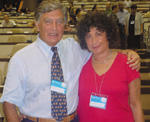|
|
Vol.
27 No. 2
March-April 2005
Chemical Engineering
by A.J. Núñez Sellés
The 5th
International Congress on Chemistry and Chemical Engineering
was held in Havana, Cuba, 18–22 October 2004, under
the sponsorship of the Cuban Chemical Society, Academy of
Sciences of Cuba, and IUPAC. The event drew 700 participants
(400 Cuban chemists) from 32 countries. The congress comprised
the II International Symposium on Biochemistry and Molecular
Biology, IV International Workshop on Natural Products Chemistry,
and sessions on Chemical Education, History of Chemistry,
Chemical Engineering, and Environmental, Organic, Inorganic,
and Analytical Chemistry.
 |
Honorary Member Awards were given to Adamo Fini of Italy (left) and Zafra Lerman of the USA. |
Opening remarks were given by Alberto J. Núñez Sellés, president of the Organizing Committee; Ernest Eliel, IUPAC representative (USA); Paulo C. Vieira, president of the Federación Latinoamericana de Asociaciones Químicas, Charles Casey, president of the American Chemical Society; William Byers, president of the American Institute of Chemical Engineers, and Irma Castro Méndez, scientific secretary of the organizing committee.
Outstanding chemists from many different countries delivered more than 800 presentations, including plenary and session lectures. Ernest Eliel delivered a welcoming lecture on the “History of Stereochemistry, 1850–2004.” Later, the University of Havana presented Eliel with the title of Doctor Honoris Causa, honoring his distinguished career in chemistry (he received a chemistry degree from the University of Havana in 1946) and his contributions to chemistry development in Cuba. Vicente Vérez Bencomo (Cuba) discussed how chemists worked with other disciplines during the research, development, production, and introduction into the Cuban health system of the first synthetic vaccine produced in Cuba against H. influenzae B. The auditorium honored both presentations with a standing ovation.
Ramón Pomés Hernández (Cuba) presented a very interesting lecture about the contributions of chemistry to the development of tourism in Cuba. Adamo Fini (Italy) presented his results about the solubility and polymorphism phenomena of pharmaceutical salts from diclofenac. Fini received an Honorary Membership in the Cuban Chemical Society for his distinguished career in chemistry and cooperation with the Cuban chemical community. V. Turk (Slovenia) discussed the function, structure, and regulation of cysteine-proteinases. Nazario Martin (Spain) presented an interesting approach to photosynthesis mimics through fullerene chemistry.
C. Hidalgo (Chile) focused his lecture on the redox signaling cascades in calcium release channels (CRC), with an interesting approach regarding oxidative stress and CRC. C.P. Casey (USA) presented his views on the challenges for chemists in this century. W. Byers (USA) summarized the American Institute of Chemical Engineers response to the changing nature of chemical engineering. L. Echegoyen (USA) delivered a highly actualized lecture about nanocarbon structures from fullerenes to nano-onions. P. Kalck (France) presented the most recent advances in the use of water-soluble complexes in homogeneous and heterogeneous catalysis.
Session lectures were presented by chemists from the Canada, USA, UK, Germany, France, Spain, Portugal, Mexico, Brazil, Argentina, Colombia, Russia, and Cuba on a wide range of topics, including, enzyme technology, natural products chemistry, organic synthesis, catalysis, and chemical education, vaccine DNA technology, molecular medicine, protease inhibitors, medicinal plants, organometallics, gene therapy, bioinformatics, and waste treatment. The scientific program also included approximately 600 posters and 100 oral presentations.
The Cuban Chemical Society acknowledged the significant contributions of the Colegio de Químicos de Puerto Rico and the American Chemical Society to the Cuban chemical community. In addition, Zafra Lerman (USA) was recognized as an Honorary Member of the Cuban Chemical Society for her contributions to strengthening cooperation between Cuban and U.S. chemical communities.
The next congress is scheduled for October 2006.
Prof. A.J. Núñez Sellés <[email protected]> has been the president of the Cuban Chemical Society since 1996. He is a titular member of the Academy of Sciences of Cuba (1996–2002) and a numerary member of the Iberoamerican Academy of Pharmacy, Spain. He has also been the director of the Center of Pharmaceutical Chemistry, in Havana, Cuba, since 1990.
Page
last modified 2 March 2005.
Copyright © 2003-2005 International Union of Pure and
Applied Chemistry.
Questions regarding the website, please contact [email protected]
|